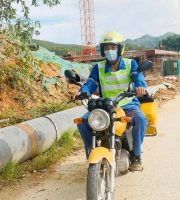Common problem handling cause analysis of hole collapse: A
. 
collision with hole wall when lifting or falling hammer or placing reinforcement framework
. 
B
. 
the casing is buried too shallow, and the hole collapse occurs in the medium sand layer or gravel layer due to punching vibration
. 
c
. 
The mud is not added to the hole in time; the mud surface in the hole is lower than the water level outside the hole, or the confined water in the hole reduces the hydrostatic pressure, or the mud proportion is not enough
. 
D
.
when drilling in medium sand layer, gravel layer and round gravel layer, the footage is too fast or the stopping time is too long
.
Prevention and treatment methods: A
.
keep vertical up and down when lifting, dropping hammer or placing steel skeleton, and strictly control the shaking range
.
B
.
according to the geological conditions of the pile location, the reasonable length of the casing should be selected, and the control standard should be passing through the medium sand layer, entering the gravel layer or the failure of the vibratory hammer to drive in
.
C
.
during drilling, timely add raw materials to continuously make slurry, so that it is higher than the water level outside the hole
.
d
.
To control the specific gravity of mud, different footage speeds should be adopted in medium sand layer, gravel layer and round gravel layer
.
e
.
Slight hole collapse, increase mud density, add cement to strengthen wall protection; serious hole collapse, use high-quality yellow mud, after the hole wall is stable, use low speed drilling
.
Cause analysis of pile deflection: a
.
the pile frame is unstable, the drilling rig is worn, and the parts are loose
.
b
.
The supporting pad is not stable, and the pile driver is displaced in the process of punching
.
C
.
when drilling, when encountering large pebbles or probe stones, or drilling in sand and gravel layers with large particle size difference, the resistance of hammer is uneven
.
Preventive measures and treatment methods: A
.
when installing the pile machine, the pile machine shall be horizontally and vertically corrected, the footage shall be controlled in different strata, and the impact height shall be changed in time
.
B
.
when the deflection is too large, fill in the stone and clay, re punch, control the impact height, and reciprocating punch to correct
.
Cause analysis of no footage or too small footage: a
.
the bit is full of clay block (paste bit)
.
b
.
Poor slag discharge
.
Preventive measures and treatment methods: A
.
strengthen slag discharge
.
B
.
reduce mud density and increase counterweight
.
C
.
when sticking the drill, the drill bit can be raised to remove the mud before drilling
.
Cause analysis of reinforcement cage deviation and deformation: a
.
the reinforcement cage is too long, without stiffening hoop or with too large spacing of stiffening ribs and insufficient rigidity, resulting in deformation
.
b
.
There is no earring on the reinforcement cage to control the thickness of the protective layer
.
c
.
The pile hole itself is inclined or displaced
.
D
.
the reinforcement cage is not placed vertically and slowly, but inserted obliquely into the hole
.
e
.
The sediment at the bottom of the hole is not cleaned up, so that the reinforcement cage can not reach the design depth
.
Prevention and treatment methods: a
.
the reinforcement is too long, it is made in sections, hoisted in sections, and welded in sections
.
B
.
on the main reinforcement of the reinforcement cage, the earrings should be welded every certain distance to control the thickness of the protective layer
.
C
.
the deviation and displacement of the pile hole itself shall be corrected by reciprocating hole cleaning before the reinforcement cage is lowered
.
d
.
The hole bottom sediment should be fully cleaned to control the sediment thickness
.
Cause analysis of suspended foot pile: a
.
the mud density is too small after hole cleaning, the hole wall collapses or concrete is not poured immediately, and the sediment is too thick
.
B
.
the hole cleaning is not complete and the residual sludge is too thick
.
C
.
the hanging reinforcement framework, conduit and other objects collide with the hole wall, causing the hole wall to collapse at the bottom of the hole without treatment
.
Prevention and treatment methods: A
.
do a good job in hole cleaning, and pour concrete immediately after meeting the requirements
.
B
.
pay attention to the mud density and keep the water level in the hole more than 0.5m higher than the water level outside the hole
.
C
.
pay attention to protect the hole wall during construction to prevent heavy objects from colliding and causing hole wall collapse
.
d
.
Before pouring concrete, the sediment thickness and mud index should be determined again
.
We respect originality! The content of this article is integrated from the Internet
.
Wuxi hairuite Construction Machinery Co., Ltd
.
provides sharing platform
.
Some articles and pictures are recommended by the Internet and netizens
.
If they are not signed, the original author can’t be determined by searching
.
If copyright issues are involved, please contact the original author to make signature correction or delete
.
thank you! @Wuxi hairuite Construction Machinery Co., Ltd
.
director follow our Yanggu haoquan Jiangsu Zhejiang Shanghai Office haoquan pick product appreciation by following the QR code below < < slide to see the next picture > > Wan Dongsheng 13373669877
.



